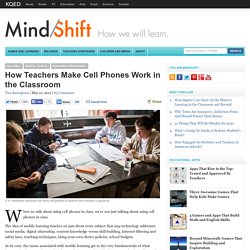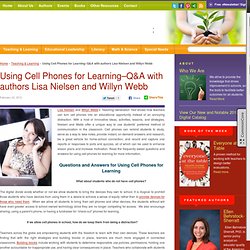

20 Blogs About Mobile Learning Worth Following. A Teacher’s Perspective On Pinterest 4.75K Views 0 Likes How do teachers approach Pinterest? Class, Turn On Your Cell Phones: It’s Time to Text. Digital Tools Getty As we noted earlier this week, cell phones are in the hands of the vast majority of adults and whether schools like it or not, they’re in the hands of most students.

While many schools still see cellphones as a distraction rather than as an educational tool, it’s hard to deny that these devices are quickly becoming the primary means by which we communicate, in or out of schools. For most teens, it’s not the “phone” part of a cellphone that they use most. Rather it’s text-messaging. Quick Question. Get Quick QuestionTM today for FREE!

Already have a Naiku account? No need to sign up here – Quick Question is included in Naiku Use Naiku’s Quick Question to poll your students and get immediate feedback – simply ask a question, and students respond using any web enabled device, such as a smartphone, tablet, netbook, or laptop. Similar to a student response system (‘clicker’) without the need for proprietary hardware! When is the right age to give a kid a cellphone? Second in a series of occasional articles on the impact of ubiquitous technology on ordinary life.

The first time Xavier Watch handled a cellphone or a computer he had just turned 4. Within weeks, he was browsing the Web on his father’s iPad and later his father’s iPhone, setting up his own music playlist and playing educational games. Now that Xavier is 5, his father is considering getting him his own smartphone. gText - A network of group communction. Mobile Learning. How Teachers Make Cell Phones Work in the Classroom. A.P.

Chemistry students use their cell phones to answer their teacher's question. When we talk about using cell phones in class, we’re not just talking about using cell phones in class. The idea of mobile learning touches on just about every subject that any technology addresses: social media, digital citizenship, content-knowledge versus skill-building, Internet filtering and safety laws, teaching techniques, bring-your-own-device policies, school budgets. At its core, the issues associated with mobile learning get to the very fundamentals of what happens in class everyday. At their best, cell phones and mobile devices seamlessly facilitate what students and teachers already do in thriving, inspiring classrooms.
In the most ideal class settings, mobile devices disappear into the background, like markers and whiteboards, pencil and paper – not because they’re not being used, but because they’re simply tools, a means to an end. In Ramsey Musallam’s A.P. Related. Understoodit - Measure Students' Understanding in Real-Time. Revisiting Cell Phone Bans in Schools. ASCD 2012 | Conference Coverage Revisiting Cell Phone Bans in Schools Twenty-four percent of K-12 schools ban cell phones altogether, and 62 percent allow phones on school grounds but ban them in the classroom, according to the most recent national data available.

But it's about time for those schools to rethink those bans, said Kevin M. How to Use Cell Phones as Learning Tools. Does your staff need Educational Technology training?

The K-12 Teachers Alliance can help you plan your in-service professional development at no additional cost. Is your lesson plan cellphone-ready? To the dismay of teachers everywhere, the cellphone has infiltrated classrooms around the world.

As an EFL teacher in the Language Institute at Bangkok University, I see many students with a Blackberry cellphone, iPhone, or other brand of smartphone. Admonishing or politely asking the students not to use their cellphones in class has little or no effect. SMART thinking! » Lesson Plans for Cellphones. I often meet educators that would like to infuse student handheld devices, computers and multimedia into the classroom curriculum, but don’t have good lesson plans for doing so.

Here’s a great resource from EdTech Magazine… Lesson Plans to infuse technology into the classroom…see all the lesson plans HERE. Below are just a few examples: from EdTechMag.com Out of This World. Cell Phones in Schools - My Experiences and More. This afternoon I Tweeted that I was thankful that my school allows teachers and students to use cell phones and social media in the classroom.

After sending out that Tweet I got a bunch of requests to elaborate, so here are my experiences using cell phones and social media in the classroom followed by some examples from others. If you have your own experience to share, please leave a message. My Experiences What prompted my Tweet today was my reaction to the great presentations made by the students in one of my classes this afternoon. Mobile Learning Lesson Plans. Cell-phone-classroom - Sample Lesson Plans. Using Cell Phones for Learning–Q&A with authors Lisa Nielsen and Willyn Webb. Lisa Nielsen and Willyn Webb‘s Teaching Generation Text shows how teachers can turn cell phones into an educational opportunity instead of an annoying distraction.

Cell phones in Education. Here a step, there a step, everywhere a step step. You may have noticed that today, steps matter. So, how many steps have you taken today: If you haven't caught on, the latest data tells us adults need at least 10,000 steps a day to remain healthy and steps they are a taking. From walking the stairs, to parking further away to taking a few laps around the block while reading the latest research paper. Pedometers are on the rise and considering that they're built into many of the mobile devices teachers and students own and love, it's no surprise that this healthy and affordable trend has taken off. So, how are our students doing? Ummm... Uh... Well, no one cares about our child obesity.
Interestingly, if we allowed children to get up and move as nature intended we'd find that activity, movement and play is not only crucial for boosting brain power, it also is a great way to alleviate ADD/ADHD symptoms. Making the Case for Cell Phones in Schools. My husband and BFF, Kip, has been with me on the last leg of my trip to the amazingly incredible CUE conference in Palm Springs (NCTIES before that.) We're now in Salt Lake City for a two hour layover and he's TRYING to read the latest Tom Clancy book. He is director of engineering of a manufacturing plant and has a genius mind for efficiency, managing people, AND making technology UNDERSTANDABLE to the average person. So, I asked him, "What is the most important point that you heard at the CUE conference? " How Should Students Use Cell Phones In School? I was inspired by a recent tweet from Joe Bower , a great person to follow on Twitter, when he posed the above question. How should students use cell phones in school?
This prompted me to research some innovative possibilities that might help increase learning both in and out of the classroom. From fun new apps to creative ways to communicate, there are plenty of new and exciting ways to harness the power of the smartphone in today’s classroom. From Toy to Tool: Cell Phones in Learning. Why Schools Should Stop Banning Cell Phones, and Use Them for Learning. Last week, a study by the Pew Internet and American Life Project found that cell phones have become “near ubiquitous”: 83 percent of American adults own one.
Over half of all adult mobile phone owners had used their phones at least once to get information they needed right away. And more than a quarter said that they had experienced a situation in the previous month in which they had trouble doing something because they did not have their phones at hand. The findings of this Pew research — the reliance of adults on their cell phones — stands in sharp contrast to the policies of many schools, where cell phones remained banned or restricted. Students likely have these same needs as adults: to get online and find information they need right away.
Get Cell Phones into Schools. It's a phone! It's a computer! No, it's mobile learning!